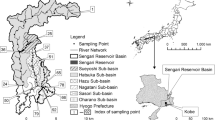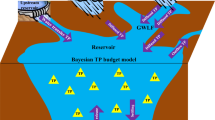Abstract
Reservoir cascade systems have attracted the attention of scientists worldwide. The present study investigates the cascade of five reservoirs (R1, R2, R3, R4, and R5) along a 192-km water channel system located in the state of Ceará, in the Brazilian semiarid region. This cascade system was implemented in 2012 to promote water availability and security to the capital of Ceará and the strategic industry and port complex of the region. However, these reservoirs have faced a progressive degradation of water quality, which has resulted in intense eutrophication and high-water treatment costs. The study evaluates the dynamics of water quality from 2013 to 2021 along this reservoir cascade (from R1 to R5). The results revealed that water quality did not improve along the cascade system, differently from previous studies on reservoirs interconnected by natural rivers. This was attributed to the low water residence time and low capacity of pollutant removal along the man-made water channel system, as well as to the high internal phosphorus loads of the reservoirs. Multiple regression models involving the explanatory variables of total phosphorus, total nitrogen, chlorophyll-a, cyanobacteria, transparency, rainfall, and volume from upstream reservoirs were obtained to determine total phosphorus concentration in downstream reservoirs, considering different combinations of reservoir pairs in the cascade and different time delays. A clear trend of R2 decline with the distance between the upstream and downstream reservoirs was observed. For example, the R2 values for the correlations adjusted between R1 and R2 (48 km), R1 and R3 (172 km), R1 and R4 (178 km), and R1 and R5 (192 km) were 0.66, 0.32, 0.22, and 0.12, respectively. On the other hand, the adoption of time delays of the order of the cumulative residence times of the reservoirs promoted a significant improvement in the R2 values. For instance, the best correlation adjusted between R1 and R5 improved from R2 = 0.12 to 0.69 by considering a time delay of 21 months. This suggests that previous data from upstream reservoirs can be used to predict current and future total phosphorus concentration in downstream reservoirs. The results from this study are important to better understand the spatiotemporal dynamics of water quality in reservoir cascade systems and thus improve water resources management, especially in drylands.







Similar content being viewed by others
Data availability
Data available upon request.
References
APHA. (2012). Standard methods for the examination of water and wastewater. American Public Health Association/American Water Works Association/Water Environment Federation.
Barbosa, I. B. R., & Cirilo, J. A. (2015). Average contribution of phosphorus in water supply reservoir – Part 1. Engenharia Sanitária e Ambiental. https://doi.org/10.1590/S1413-41522015020000098008
Campos, J. N. B., Lima Neto, I. E., Studart, T. M. C., & Nascimento, L. S. V. (2016). Trade-off between reservoir yield and evaporation losses as a function of lake morphology in semi-arid Brazil. Anais Da Academia Brasileira De Ciências, 88(2), 1113–1125. https://doi.org/10.1590/0001-3765201620150124
Carneiro, B. L. D. S., Rocha, M. J. D., Barros, M. U. G., Paulino, W. D., & Lima Neto, I. E. (2023). Predicting anoxia in the wet and dry periods of tropical semiarid reservoirs. Journal of Environmental Management, 326, 116720. https://doi.org/10.1016/j.jenvman.2022.116720
Carvalho, T. M. N., Lima Neto, I. E., & Souza Filho, F. A. (2022). Uncovering the influence of hydrological and climate variables in chlorophyll-A concentration in tropical reservoirs with machine learning. Environmental Science and Pollution Research, 29(49), 74967–74982. https://doi.org/10.1007/s11356-022-21168-z
Cavalcante, H., Araújo, F., Becker, V. (2018). Phosphorus dynamics in the water of tropical semiarid reservoirs in a prolonged drought period. Acta Limnologica Brasiliensia, 30(0). https://doi.org/10.1590/s2179-975x1617
Chen, Q., Chen, Y., Yang, J., Maberly, S. C., Zhang, J., & Ni, J. (2021). Bacterial communities in cascade reservoirs along a large river. Limnology and Oceanography, 66, 4363–4374.
COGERH, (2022). Companhia de Gestão dos Recursos Hídricos do Ceará - Portal Hidrológico do Ceará. Página Virtual. https://www.hidro.ce.gov.br.
França, J. M. B., Silva, S. M. O., Monteiro, C. M. G., Paulino, W. D., & Capelo Neto, J. (2022). Qualidade da água em um sistema de reservatórios em cascata – um estudo de caso no semiárido brasileiro. Engenharia Sanitária e Ambiental, 27(1), 113–123. https://doi.org/10.1590/s1413-415220200328
Freire, L. L., Costa, A. C., & Lima Neto, I. E. (2021). Spatio-temporal patterns of river water quality in the semiarid Northeastern Brazil. Water, Air, & Soil Pollution, 232, 452. https://doi.org/10.1007/s11270-021-05406-7
Freire, L. L., Costa, A. C., & Lima Neto, I. E. (2023). Effects of rainfall and land use on nutrient responses in rivers in the Brazilian semiarid region. Environmental Monitorind and Assessment, 195, 652. https://doi.org/10.1007/s10661-023-11281-y
Ganassin, M. J. M., Muñoz-Mas, R., Machado de Oliveira, F. J., Muniz, C. M., Santos, N. C. L., Berthou, E. G., & Gomes, L. C. (2021). Effects of reservoir cascades on diversity, distribution, and abundance of fish assemblages in three Neotropical basins. Science of the Total Environment, 778, 146246. https://doi.org/10.1016/j.scitotenv.2021.146246
Guimarães, B. M. D. M., & Lima Neto, I. E. (2023). Analysis of total phosphorus and chlorophyll a correlations in Ceará reservoirs, Brazil. Revista Brasileira de Ciências Ambientais, 58, 91–102. https://doi.org/10.5327/Z2176-94781521
Liao, S. W., Gau, H.-S., Lai, W. L., Chen, J. J., & Lee, C. G. (2008). Identification of pollution of Tapeng Lagoon from neighbouring rivers using multivariate statistical method. Journal of Environmental Management, 88(2), 286–292. https://doi.org/10.1016/j.jenvman.2007.02.010
Lima Neto, I. E., Wiegand, M. C., & Araújo, J. C. (2011). Sediment redistribution due to a dense reservoir network in a large semi-arid Brazilian basin. Hydrological Sciences Journal, 56(2), 319–333. https://doi.org/10.1080/02626667.2011.553616
Lima Neto, I. E., Medeiros, P. H. A., Costa, A. C., Wiegand, M. C., Barros, A. R. M., & Barros, M. U. G. (2022). Assessment of phosphorus loading dynamics in a tropical reservoir with high seasonal water level changes. Science of the Total Environment, 815, 152875. https://doi.org/10.1016/j.scitotenv.2021.152875
Lira, C. C. S., Medeiros, P. H. A., Lima Neto, I. E. (2020). Modelling the impact of sediment management on the trophic state of a tropical reservoir with high water storage variations. Annals of the Brazilian Academy of Sciences, 92(1). https://doi.org/10.1590/0001-3765202020181169
Mesquita, J. B. de F., Lima Neto, I. E. (2022). Coupling hydrological and hydrodynamic models for assessing the impact of water pollution on lake evaporation. Sustainability, 14(20), 13465. https://doi.org/10.3390/su142013465
Moriasi, D. N., Gitau, M. W., Pai, N., Daggupati, P. (2015). Hydrologic and water quality models: Performance measures and evaluation criteria. Transactions of the ASABE, 58(6), 1763–1785. https://doi.org/10.13031/trans.58.10715
Moura, D. S., Lima Neto, I. E., Clemente, A., Oliveira, S., Pestana, C. J., Melo, A. P., & Capelo-Neto, J. (2020). Modeling phosphorus exchange between bottom sediment and water in tropical semiarid reservoirs. Chemosphere, 246, 125686. https://doi.org/10.1016/j.chemosphere.2019.125686
Pompêo, M., Moschini-Carlos, V., López-Doval, J. C., Abdalla-Martins, N., Cardoso-Silva, S., Freire, R. H. F., Beghelli, F. G. S., Brandimarte, A. L., Rosa, A. H., & López, P. (2017). Nitrogen and phosphorus in cascade multi-system tropical reservoirs: Water and sediment. Limnological Review, 17(3), 133–150. https://doi.org/10.1515/limre-2017-0013
Rabelo, U. P., Dietrich, J., Costa, A. C., Simshäuser, M. N., Scholz, F. E., Nguyen, V. T., & Lima Neto, I. E. (2021). Representing a dense network of ponds and reservoirs in a semi-distributed dryland catchment model. Journal of Hydrology, 603, 127103. https://doi.org/10.1016/j.jhydrol.2021.127103
Rabelo, U. P., Costa, A. C., Dietrich, J., Fallah-Mehdipour, E., van Oel, P., & Lima Neto, I. E. (2022). Impact of Dense Networks of reservoirs on streamflows at dryland catchments. Sustainability, 14(21), 14117. https://doi.org/10.3390/su142114117
Rocha, M. J. D., & Lima Neto, I. E. (2021). Modeling flow-related phosphorus inputs to tropical semiarid reservoirs. Journal of Environmental Management, 295, 113123. https://doi.org/10.1016/j.jenvman.2021.113123
Rocha, M. J. D., & Lima Neto, I. E. (2022). Internal phosphorus loading and its driving factors in the dry period of Brazilian semiarid reservoirs. Journal of Environmental Management, 312, 114983. https://doi.org/10.1016/j.jenvman.2022.114983
Rocha, S. M. G., Molinas, E., Rodrigues, I. S., & Lima Neto, I. E. (2023). Assessment of total evaporation rates and its surface distribution by tridimensional modelling and remote sensing. Journal of Environmental Management, 327, 116846. https://doi.org/10.1016/j.jenvman.2022.116846
Silva, T. D., & Hornberger, G. M. (2019). Assessing water management alternatives in a multipurpose reservoir cascade system in Sri Lanka. Journal of Hydrology: Regional Studies, 25, 100624. https://doi.org/10.1016/j.ejrh.2019.100624
Singh, K. P., Malik, A., Mohan, D., & Sinha, S. (2004). Multivariate statistical techniques for the evaluation of spatial and temporal variations in water quality of Gomti River (India)—a case study. Water Research, 38(18), 3980–3992. https://doi.org/10.1016/j.watres.2004.06.011
Soares, L. M. V., Calijuri, M. C. (2022). Restoration from eutrophication in interconnected reservoirs: Using a model approach to assess the propagation of water quality improvements downstream along a cascade system. Environmental Modelling & Software, 149. https://doi.org/10.1016/j.envsoft.2022.105308.
Soares, L. M. V., Calijuri, M. C., Silva, T. F. G., Moraes Novo, E. M. L., Cairo, C. T., Barbosa, C. C. F. (2020). A parameterization strategy for hydrodynamic modelling of a cascade of poorly monitored reservoirs in Brazil. Environmental Modelling & Software, 134. https://doi.org/10.1016/j.envsoft.2020.104803.
Team R. C. (2018). R: A language and environment for statistical computing. https://www.r-project.org/.
Wang, Y., Li, B.-L., Liu, J. J., Feng, Q., Liu, W., Wang, X., & He, H. (2022). Effects of cascade reservoir systems on the longitudinal distribution of sediment characteristics: A case study of the Heihe River Basin. Environmental Science and Pollution Research, 2022(29), 2911–2923. https://doi.org/10.1007/s11356-021-15760-y
Wiegand, M. C., Nascimento, A. T. P., Costa, A. C., & Lima Neto, I. E. (2021). Trophic state changes of semi-arid reservoirs as a function of the hydro-climatic variability. Journal of Arid Environments, 184, 104321. https://doi.org/10.1016/j.jaridenv.2020.104321
Zhang, P., Yanpeng, C., Xie, Y., Yi, Y., Yang, W., & Li, Z. (2022). Effects of a cascade reservoir system on runoff and sediment yields in a River Basin of southwestern China. Ecological Engineering, 179, 106616. https://doi.org/10.1016/j.ecoleng.2022.106616
Zhang, X., Yang, H., Zhang, W., Fenicia, F., Peng, H., & Xu, G. (2022). Hydrologic impacts of cascading reservoirs in the middle and lower Hanjiang River basin under climate variability and land use change. Journal of Hydrology: Regional Studies, 44, 101253. https://doi.org/10.1016/j.ejrh.2022.101253
Acknowledgements
The authors thank the Water Resources Management Company of Ceará (COGERH) for providing the field data.
Funding
The present study was supported through the Brazilian National Council for Scientific and Technological Development—CNPq (Research Grant 150326/2022–0).
Author information
Authors and Affiliations
Contributions
MCAG: conceptualization, formal analysis, investigation, methodology, and writing—original draft preparation; MUGB: conceptualization and writing—reviewing and editing; and IELN: conceptualization, formal analysis, writing—reviewing and editing, supervision, and project administration.
Corresponding author
Ethics declarations
Ethics approval and consent to participate
Not applicable.
Consent for publication
Not applicable.
Competing interests
The authors declare that they have no competing interests.
Additional information
Publisher's Note
Springer Nature remains neutral with regard to jurisdictional claims in published maps and institutional affiliations.
Rights and permissions
Springer Nature or its licensor (e.g. a society or other partner) holds exclusive rights to this article under a publishing agreement with the author(s) or other rightsholder(s); author self-archiving of the accepted manuscript version of this article is solely governed by the terms of such publishing agreement and applicable law.
About this article
Cite this article
Goes, M.C.A., Barros, M.U.G. & Neto, I.E.L. Prediction of total phosphorus in reservoir cascade systems. Environ Monit Assess 195, 1550 (2023). https://doi.org/10.1007/s10661-023-12155-z
Received:
Accepted:
Published:
DOI: https://doi.org/10.1007/s10661-023-12155-z




